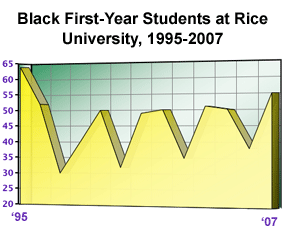



The Roller-Coaster Ride of Black Freshmen at Rice University: But This Year the News Is Good
 The first students enrolled at Rice University in 1912. For more than half a century the university was faithful to the racial stipulations of its founder that no black students be admitted. After a legal battle in 1965 to overturn the “whites only” provision of the university’s charter, black students were finally admitted to Rice in 1966.
The first students enrolled at Rice University in 1912. For more than half a century the university was faithful to the racial stipulations of its founder that no black students be admitted. After a legal battle in 1965 to overturn the “whites only” provision of the university’s charter, black students were finally admitted to Rice in 1966.
But racial integration came slowly until 1993, when new Rice president Malcolm Gillis made racial diversity a priority. In just two years, blacks were 10 percent of the incoming class at Rice University.
But in 1996 the Fifth Circuit Court of Appeals in the Hopwood case ruled that the race-sensitive admissions program at the University of Texas law school was unconstitutional. Legal counsel at Rice decided that the decision also applied to their university. Race-sensitive admissions were halted and black admissions plummeted.
Since that time the number of black first-year students has widely fluctuated, despite the fact that race-sensitive admissions were reinstated after the 2003 Grutter ruling by the U.S. Supreme Court. But this year there is good news to report. Rice expects 55 black students to matriculate this fall, an increase of nearly 45 percent from a year ago.
Another 37 students expected to enroll this fall at Rice self-identified themselves as “multiracial.” In past years students who checked both boxes for white and black on their admission form were classified as black. Undoubtedly, many of this year’s students in the multiracial category have black ancestors. Therefore, the increase in the number of students with African-American heritage at Rice this year is actually greater than the official numbers indicate.

![]()
Copyright © 2007. The Journal of Blacks in Higher Education. All rights reserved.